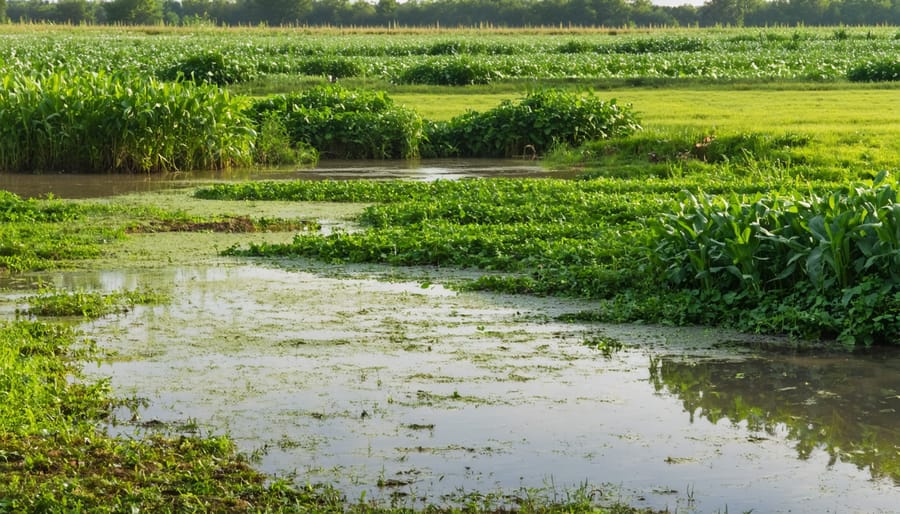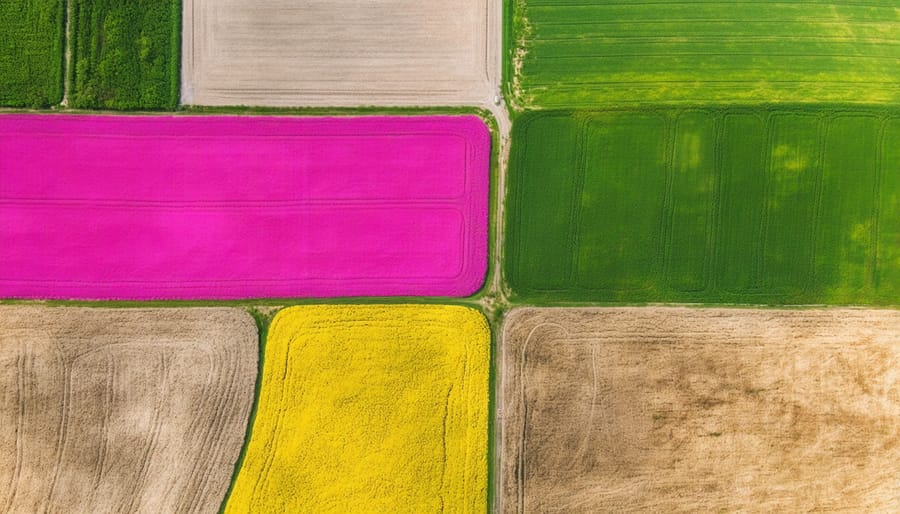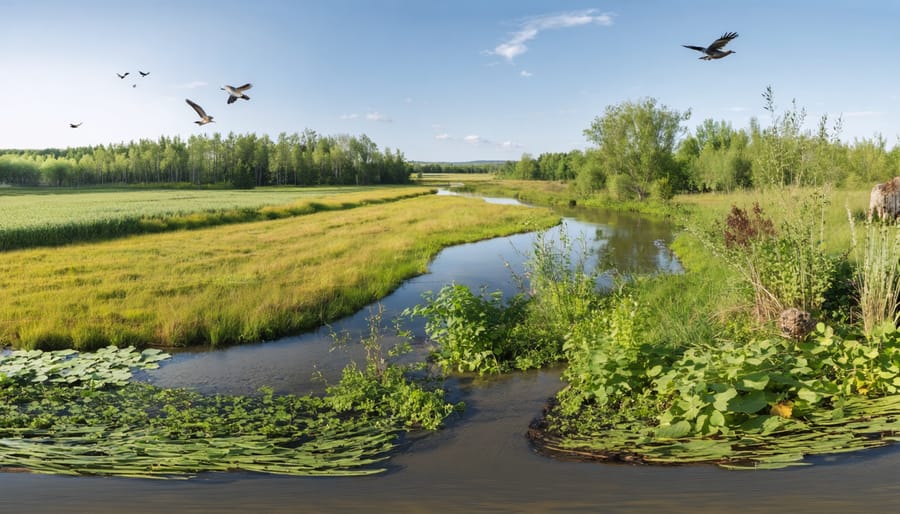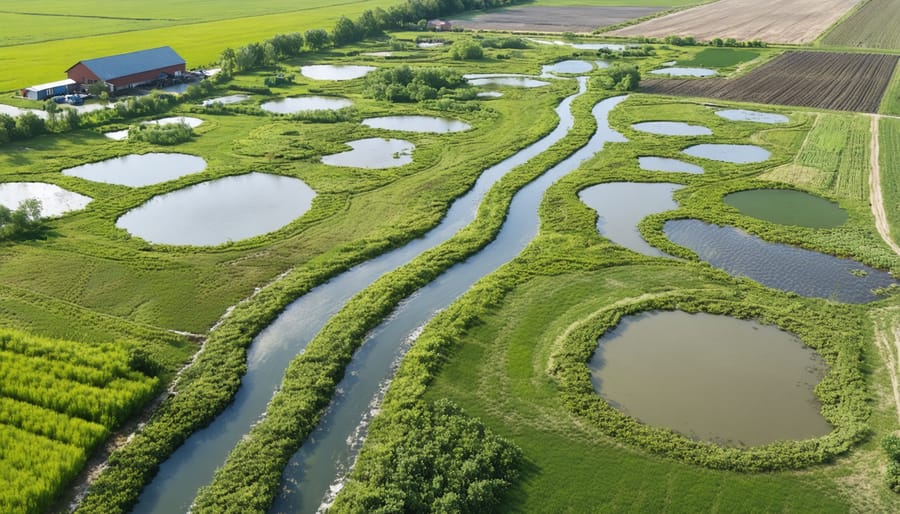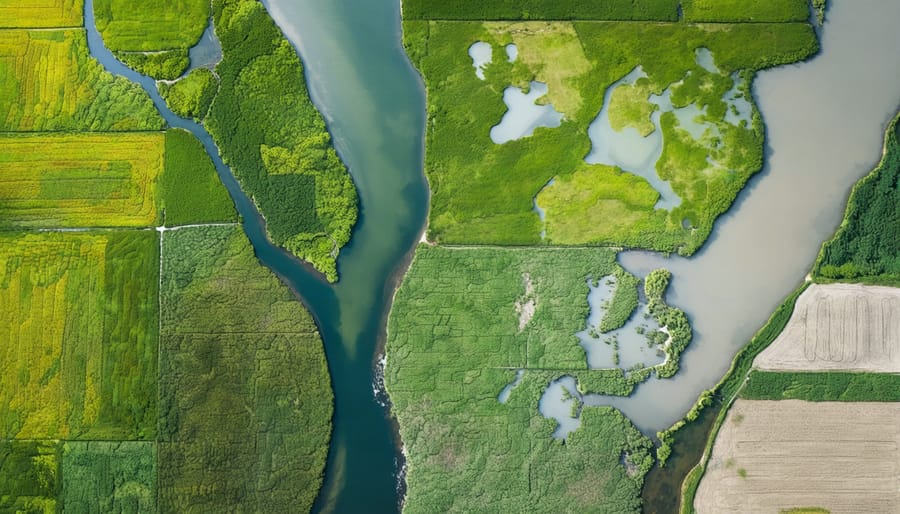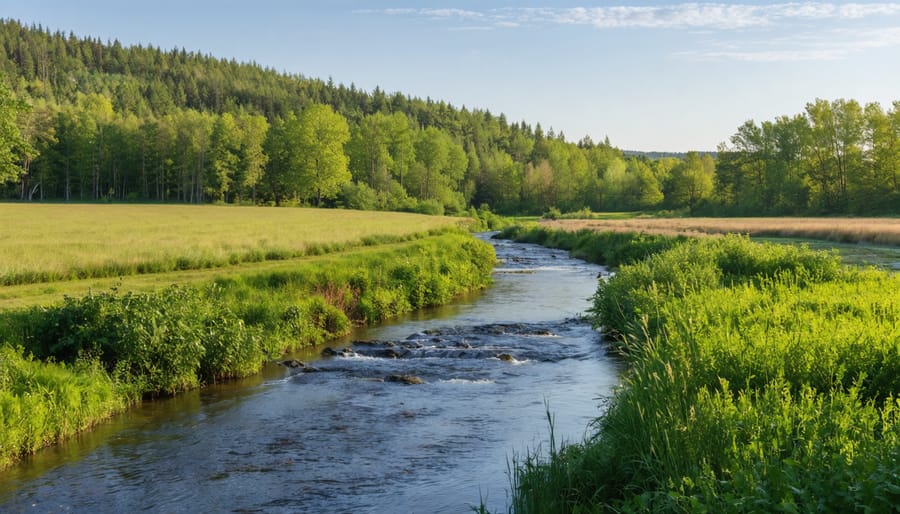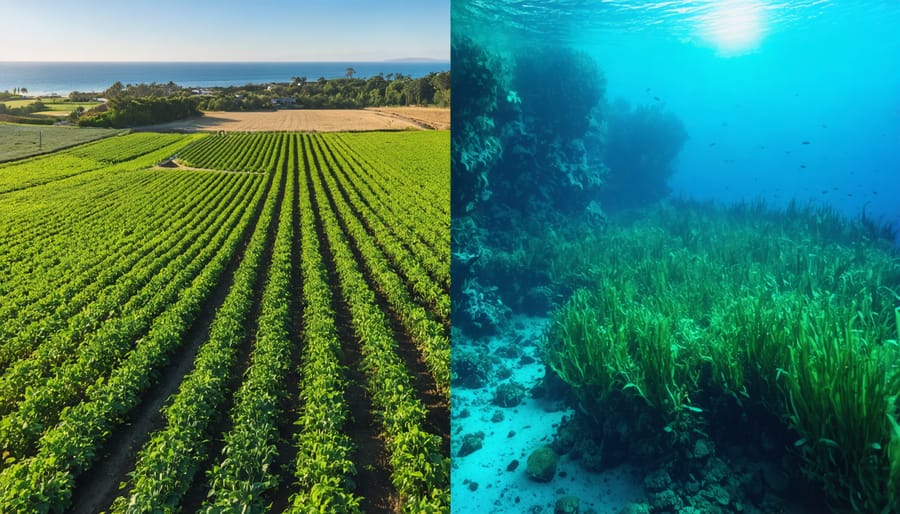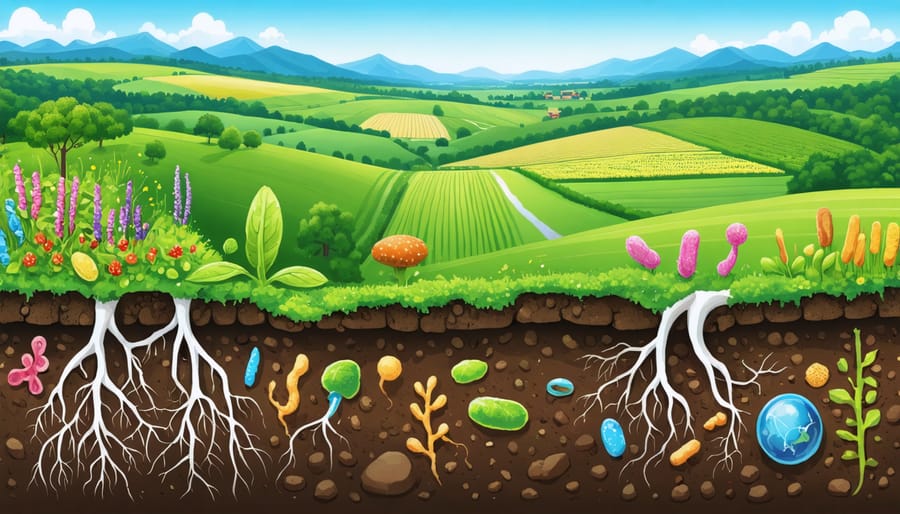Transform your agricultural landscape into a thriving ecosystem by integrating water-based biodiversity practices across your operation. Strategic placement of wetland buffers, diverse crop rotation patterns, and native plant corridors enhances your farm’s natural resilience while supporting essential pollinators and beneficial insects.
In Alberta’s unique climate, agro biodiversity serves as a powerful shield against extreme weather events, reducing irrigation needs by up to 30% through improved soil structure and water retention. Our province’s successful farmers have documented increased yields of 15-25% after implementing integrated aquatic systems, proving that biodiversity and productivity go hand in hand.
From the Red Deer River Valley to the Prairie pothole region, Canadian farmers are pioneering innovative approaches to agricultural biodiversity that combine traditional knowledge with cutting-edge water management techniques. These methods not only protect vital water resources but also create robust, self-sustaining farming systems that require fewer external inputs while delivering consistent, high-quality yields.

The Power of Water-Based Ecosystems in Agriculture
Natural Pest Control Benefits
Natural water features on farms, such as ponds, wetlands, and streams, play a crucial role in controlling agricultural pests without relying on chemical pesticides. Here in Alberta, we’ve seen remarkable success stories where farmers have integrated these aquatic ecosystems into their pest management strategies.
These water bodies support diverse populations of beneficial insects, birds, and amphibians that naturally prey on crop pests. For instance, dragonflies emerging from farm ponds can consume up to hundreds of mosquitoes and crop-damaging flies daily. Wetland-dwelling birds like red-winged blackbirds help control grasshopper populations, while frogs and toads feast on slugs and harmful insects.
Research from the University of Alberta shows that farms with integrated water features experience up to 45% fewer pest outbreaks compared to those without. The key is maintaining healthy aquatic ecosystems that support these natural pest controllers. Many Alberta farmers have found success by creating small retention ponds near their fields, which not only aid in pest control but also provide irrigation benefits during dry spells.
To maximize these benefits, consider incorporating native aquatic plants around water features and maintaining buffer zones that allow beneficial species to thrive.
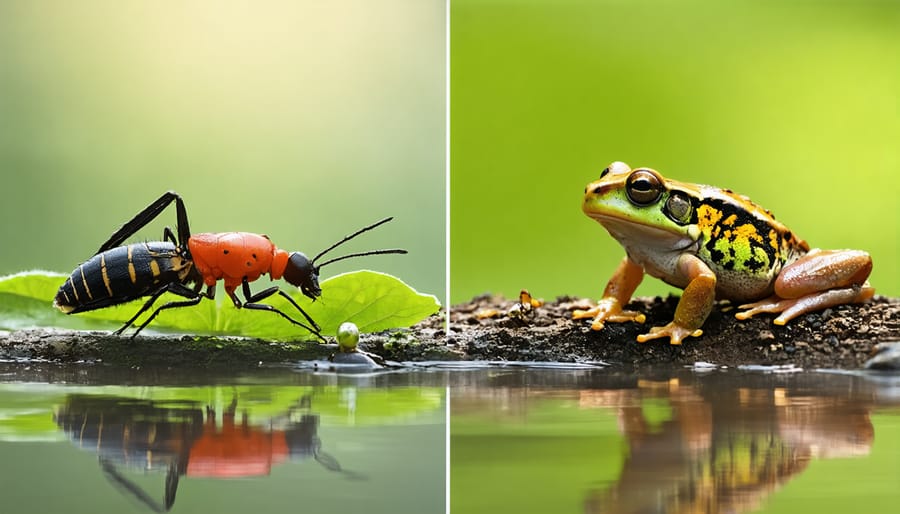
Water Quality Enhancement
In Alberta’s diverse agricultural landscape, biodiversity plays a crucial role in maintaining water quality across our farms and watersheds. Healthy ecosystems with varied plant and animal species act as natural water filtration systems, removing excess nutrients, sediments, and potential contaminants from water sources.
Native plants along waterways and wetlands are particularly effective at improving water quality. Their root systems help prevent soil erosion, while beneficial microorganisms in the soil break down agricultural inputs before they reach water bodies. For example, farmers in the Red Deer River watershed have reported clearer water and reduced sediment loads after implementing buffer zones with mixed native vegetation.
Aquatic organisms, from tiny zooplankton to larger fish species, also contribute to water purification. These creatures form a complex food web that processes organic matter and maintains balanced nutrient levels. Many Alberta farmers are now incorporating constructed wetlands into their operations, creating habitats that naturally filter runoff while supporting local wildlife.
By protecting and enhancing biodiversity on your farm, you’re not just supporting cleaner water – you’re also reducing water treatment costs and building resilience against drought and flooding events.
Alberta Success Stories: Farm Ponds That Work
The Mitchell Farm Transformation
Located just outside of Olds, Alberta, the Mitchell family farm has become a shining example of successful pond ecosystem integration in agricultural land. In 2018, Sarah and James Mitchell transformed their 10-hectare conventional grain operation by introducing a 2,000-square-metre pond system, complete with native aquatic vegetation and carefully selected fish species.
The Mitchells worked closely with local conservation experts to design a system that would serve multiple purposes: irrigation, wildlife habitat, and natural pest control. They planted cattails, bulrushes, and water lilies around the pond’s edges, creating crucial habitat zones for beneficial insects and native bird species.
Within two years, the farm saw remarkable changes. Water retention improved significantly, reducing irrigation needs by approximately 30% during dry spells. The pond system also attracted natural predators like dragonflies, which help control pest populations in their adjacent canola fields.
“The transformation wasn’t just about water management,” explains Sarah Mitchell. “We’ve seen the return of northern pintails and even some endangered northern leopard frogs. The pond has become the heart of our farm’s ecosystem.”
The Mitchells now host regular farm tours for local agricultural groups, sharing their experience and helping others understand the practical benefits of integrating aquatic biodiversity into farming operations. Their success has inspired five neighbouring farms to implement similar systems, creating a growing network of biodiversity-friendly agriculture in the region.
Measuring Economic Benefits
The economic benefits of aquatic biodiversity in agricultural systems are substantial and measurable. Alberta farmers implementing integrated aquatic systems have reported cost savings of 15-20% on irrigation expenses through improved water retention and natural filtration processes. A recent study conducted by the University of Alberta showed that farms utilizing diverse aquatic ecosystems experienced a 25% reduction in fertilizer costs due to natural nutrient cycling.
In the Red Deer region, farmers who maintained healthy wetland areas alongside their crops documented yield improvements of up to 30% in adjacent fields, particularly during drought conditions. These natural water systems act as reservoirs, providing crucial moisture during dry periods while supporting beneficial insects and organisms that contribute to soil health.
The financial advantages extend beyond direct farming costs. Many Canadian farmers have successfully developed additional revenue streams through sustainable aquaculture practices, averaging $5,000-$8,000 per hectare annually from fish farming in integrated systems. Furthermore, government incentives for maintaining wetland biodiversity can offset implementation costs by up to 40%.
Local success stories include the Peterson family farm near Lethbridge, which saved approximately $12,000 annually on pest control after establishing a diverse pond system that naturally attracts beneficial predators. Their experience demonstrates how investing in aquatic biodiversity can generate both environmental and economic returns within 2-3 growing seasons.
Building Your Farm’s Aquatic Ecosystem
Site Selection and Design
When selecting a site for aquatic features in your agricultural landscape, start by conducting a thorough assessment of your land’s natural water patterns. Look for areas where water naturally collects or flows, as these locations often make ideal spots for pond development or riparian buffer zones.
Consider your soil type and drainage patterns, as these factors significantly influence water retention and ecosystem stability. Clay soils hold water well but may require additional structural support, while sandy soils might need extra lining to prevent excessive seepage. In Alberta’s climate, it’s crucial to account for both spring runoff and periods of drought when planning your site.
The size and shape of your aquatic feature should complement your existing farming operations. For most Alberta farms, dedicating 5-10% of agricultural land to water features provides optimal biodiversity benefits without compromising production. Design your water features with varying depths – shallow areas support emergent vegetation while deeper sections provide refuge for aquatic species during winter months.
Include gradual slopes (ideally 4:1 or gentler) around the edges of ponds and wetlands to facilitate wildlife access and prevent erosion. Consider incorporating islands or peninsulas to create additional habitat edges and protect against prevailing winds. These features also provide safe nesting sites for waterfowl, a valuable component of Alberta’s agricultural landscape.
Remember to maintain clear access points for maintenance and monitoring, and plan for seasonal changes in water levels. Strategic placement near existing natural areas can create wildlife corridors, enhancing the overall biodiversity value of your farm while supporting essential ecosystem services like pollination and natural pest control.

Species Selection Guide
In Alberta’s diverse agricultural landscape, selecting the right species for your farm’s biodiversity strategy is crucial for success. Our climate’s unique characteristics demand careful consideration of both terrestrial and native aquatic plants that can thrive in our conditions.
For field margins and buffer zones, hardy perennials like yarrow, purple coneflower, and wild bergamot offer excellent pollinator support while maintaining soil stability. These species are particularly well-suited to our Zone 2-4 growing conditions and require minimal maintenance once established.
When considering cover crops, choose cold-hardy varieties like fall rye, winter wheat, and hairy vetch. These species provide excellent soil protection during our harsh winters while contributing to organic matter content. For summer cover, consider white clover and alfalfa, which fix nitrogen and support beneficial insects.
In wetland areas and drainage systems, cattails and sedges play vital roles in water filtration and habitat creation. These species are particularly effective at reducing erosion and managing excess nutrients from agricultural runoff.
For beneficial insects, incorporate flowering herbs like dill, fennel, and borage throughout your operation. These plants attract predatory insects that help control pest populations naturally.
Tree species such as trembling aspen, white spruce, and Manitoba maple make excellent windbreaks while providing habitat for birds and small mammals. When planted strategically, these species can reduce wind erosion and improve moisture retention across your fields.
Remember to source your plant materials from local suppliers who understand our growing conditions and can provide region-specific advice for establishment and maintenance.
The remarkable benefits of aquatic biodiversity in agricultural systems make it a crucial investment for Canadian farmers. From improved water quality and increased crop resilience to enhanced ecosystem services and sustainable fish production, these water-based solutions offer multiple pathways to farm prosperity. By implementing measures like constructed wetlands, fish-friendly irrigation systems, and integrated aquaculture, Alberta farmers can create resilient agricultural systems that work in harmony with nature.
Take the first step today by assessing your farm’s water features and identifying opportunities for biodiversity enhancement. Connect with local agricultural extension services, join community initiatives, or partner with neighbouring farms to share resources and knowledge. Remember, every action towards increasing aquatic biodiversity, no matter how small, contributes to the long-term sustainability of Canadian agriculture and helps preserve our precious water resources for future generations. Together, we can build a more diverse, productive, and sustainable agricultural landscape across Alberta and beyond.

